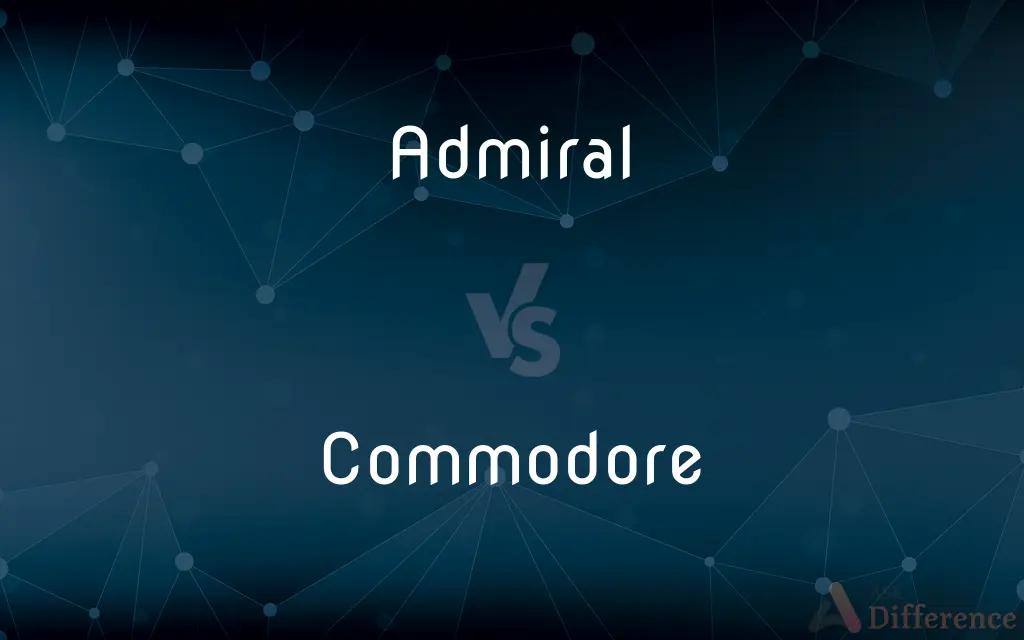Admiral vs. Commodore — What's the Difference?
By Fiza Rafique & Urooj Arif — Updated on March 27, 2024
An admiral is a high-ranking naval officer, often in command of a fleet or navy, while a commodore is a lower-ranking officer, traditionally leading a single ship or a small group of ships.

Difference Between Admiral and Commodore
Table of Contents
ADVERTISEMENT
Key Differences
Admirals hold one of the highest ranks in naval forces, responsible for major operational commands and strategic decision-making within a fleet or an entire navy. They play crucial roles in planning military operations, formulating naval strategy, and sometimes serving in high-level administrative positions. In contrast, commodores occupy a position that, while still prestigious, is typically below that of an admiral. Commodores often command a single vessel, a squadron, or a small task force, focusing on tactical missions and the operational leadership of their assigned units.
The rank of admiral is divided into several grades, such as rear admiral, vice admiral, and full admiral, each representing higher levels of responsibility and command within a navy. Commodores, on the other hand, do not have such subdivisions in their rank, though in some navies, the term can denote a temporary or honorary position given to a senior captain taking on additional responsibilities.
In terms of insignia and symbols of rank, admirals typically wear multiple stars or equivalent symbols, reflecting their high standing in the naval hierarchy. Commodores, while also displaying distinct insignia, generally have less elaborate symbols, often signifying their rank with a single star or equivalent emblem, highlighting the difference in their command status and responsibilities.
Admirals are involved in strategic-level decisions, often working closely with national defense and government officials to shape naval policy and military strategy. Commodores, while they may participate in strategic planning, are more directly engaged in the execution of naval operations, leading their ships or squadrons in carrying out the missions and strategies devised by higher command.
The path to becoming an admiral involves a lengthy and distinguished career within the navy, including extensive experience in naval operations, command positions, and often, staff roles in strategic planning. Achieving the rank of commodore also requires a significant naval career but is generally seen as a stepping stone to higher ranks, including those of an admiral, for officers who continue to excel in their service.
ADVERTISEMENT
Comparison Chart
Rank Level
Highest ranks in the navy.
Lower than admiral, above captain.
Command Responsibility
Fleet, navy, or major naval operations.
Single ship, squadron, or small task force.
Subdivisions
Several (e.g., rear admiral, vice admiral, full admiral).
Typically none.
Insignia
Multiple stars or equivalent symbols.
Single star or equivalent emblem.
Role in Strategy
Strategic planning and high-level decisions.
Tactical missions and operational leadership.
Compare with Definitions
Admiral
A senior naval officer in command of a fleet.
The admiral directed the naval forces during the operation.
Commodore
Naval officer commanding a single ship or squadron.
The commodore led the squadron on a reconnaissance mission.
Admiral
Wears insignia with multiple stars.
The uniform of the admiral bore four stars, indicating his rank.
Commodore
A rank above captain, leading small task forces.
As a commodore, she organized the maritime patrol operations.
Admiral
Holder of the highest naval ranks.
As an admiral, she was responsible for strategic military decisions.
Commodore
Does not typically have subdivisions.
He was promoted to commodore, taking on greater responsibilities.
Admiral
Involved in national defense strategy.
The admiral met with government officials to discuss naval policy.
Commodore
Wears a single star as insignia.
His uniform displayed a single star, signifying his rank as commodore.
Admiral
Commands large-scale naval operations.
The admiral oversaw the deployment of the naval fleet to the Pacific.
Commodore
Involved in tactical naval missions.
The commodore executed the strategic plan with precision and expertise.
Admiral
Admiral is one of the highest ranks in some navies. In the Commonwealth nations and the United States, a "full" admiral is equivalent to a "full" general in the army, and is above vice admiral and below admiral of the fleet, or fleet admiral.
Commodore
A commissioned rank formerly used in the US Navy that was above captain and below rear admiral. Abolished in 1899, it was restored temporarily during World War II and in the early 1980s.
Admiral
The most senior commander of a fleet or navy.
Commodore
One who holds this rank.
Admiral
A butterfly which has dark wings with bold red or white markings.
Commodore
Used as an honorary title for a captain in the US Navy in command of a fleet division or squadron.
Admiral
The commander in chief of a fleet.
Commodore
The senior captain of a naval squadron or merchant fleet.
Admiral
A flag officer.
Commodore
The presiding officer of a yacht club.
Admiral
A commissioned rank in the US Navy or Coast Guard that is above vice admiral and below Fleet Admiral.
Commodore
A naval officer holding a rank between captain and rear admiral.
Admiral
One who holds the rank of admiral, Fleet Admiral, rear admiral, or vice admiral.
Commodore
(nautical) A (temporary) commander over a collection of ships who is not an admiral.
Admiral
Any of various brightly colored nymphalid butterflies of the genera Limenitis and Vanessa, especially V. atalanta, having black wings with red bands.
Commodore
(nautical) The leading ship in a fleet of merchantmen.
Admiral
(Archaic) The ship carrying an admiral; flagship.
Commodore
(nautical) The president of a yacht club.
Admiral
A naval officer of the highest rank; the commander of a country's naval forces.
Commodore
(nautical) A yacht-club president's vessel in a regatta.
Admiral
A naval officer of high rank, immediately below Admiral of the Fleet; the commander of a fleet or squadron.
Commodore
A commodore admiral.
Admiral
A flag officer in the United States Navy or Coast Guard of a grade superior to vice admiral and junior to admiral of the fleet (when that grade is used). An admiral is equal in grade or rank to a four-star general.
Commodore
A rear admiral (lower half).
Admiral
The ship which carries the admiral, the flagship; also, the most considerable ship of a fleet.
Commodore
(entomology) Any of various nymphalid butterflies of the Asian genus Parasarpa.
Admiral
(obsolete) A prince or Saracen leader under the Sultan.
Commodore
An officer who ranks next above a captain; sometimes, by courtesy, the senior captain of a squadron. The rank of commodore corresponds with that of brigadier general in the army.
Admiral
Any of various nymphalid butterflies of the genera Kaniska, Limenitis and Vanessa, especially a red admiral or white admiral.
Commodore
A captain commanding a squadron, or a division of a fleet, or having the temporary rank of rear admiral.
Admiral
A naval officer of the highest rank; a naval officer of high rank, of which there are different grades. The chief gradations in rank are admiral, vice admiral, and rear admiral. The admiral is the commander in chief of a fleet or of fleets.
Commodore
A title given by courtesy to the senior captain of a line of merchant vessels, and also to the chief officer of a yachting or rowing club.
Admiral
The ship which carries the admiral; also, the most considerable ship of a fleet.
Like some mighty admiral, dark and terrible, bearing down upon his antagonist with all his canvas straining to the wind, and all his thunders roaring from his broadsides.
Commodore
A familiar for the flagship, or for the principal vessel of a squadron or fleet.
Admiral
A handsome butterfly (Pyrameis Atalanta) of Europe and America. The larva feeds on nettles.
Commodore
A commissioned naval officer who ranks above a captain and below a rear admiral; the lowest grade of admiral
Admiral
The supreme commander of a fleet; ranks above a vice admiral and below a fleet admiral
Admiral
Any of several brightly colored butterflies
Common Curiosities
Can a commodore become an admiral?
Yes, a commodore can be promoted to admiral after demonstrating exemplary leadership and accumulating significant naval experience.
How does the rank of admiral differ from commodore?
The rank of admiral is higher, with responsibilities for larger scale operations and strategic planning, whereas commodores focus on specific vessels or tactical missions.
What insignia do admirals and commodores wear?
Admirals wear multiple stars or equivalent symbols, while commodores typically wear a single star or emblem.
What is the main focus of a commodore in naval operations?
Commodores focus on commanding their ships or squadrons, leading tactical missions, and implementing operational strategies.
What is an admiral?
An admiral is one of the highest-ranking officers in a navy, responsible for major operational commands and strategic decisions.
Are there different grades of admirals?
Yes, there are several grades, such as rear admiral, vice admiral, and full admiral, each indicating higher levels of command and responsibility.
What kind of missions might a commodore be assigned to?
Missions can include patrol operations, reconnaissance, engagement in combat operations, or leading a task force in specific operations.
What is a commodore?
A commodore is a naval rank typically commanding a single vessel, squadron, or small task force, positioned below an admiral.
How is the leadership of an admiral different from that of a commodore?
Admirals lead at the strategic level, affecting the navy's overall direction, while commodores are more involved in the operational and tactical aspects of naval missions.
What is the career path to becoming an admiral?
It involves a distinguished naval career with experience in command positions, operational roles, and sometimes strategic planning staff positions.
How do admirals and commodores contribute to naval strategy?
Admirals shape overall naval strategy and policy, while commodores execute strategic plans through operational leadership.
What roles do admirals play in naval operations?
Admirals plan military operations, formulate naval strategies, and may serve in high-level administrative roles.
Does the rank of commodore have subdivisions?
Generally, the rank of commodore does not have subdivisions and is a position above captain.
Is the rank of commodore permanent?
In some navies, commodore can be a temporary or honorary rank, while in others, it is a permanent step in the officer's career ladder.
What distinguishes the responsibilities of admirals and commodores in times of war?
During war, admirals are key in strategizing and directing naval campaigns, while commodores lead front-line operations, applying strategies in combat and tactical missions.
Share Your Discovery

Previous Comparison
Poster vs. Postcard
Next Comparison
Shop vs. ParlourAuthor Spotlight
Written by
Fiza RafiqueFiza Rafique is a skilled content writer at AskDifference.com, where she meticulously refines and enhances written pieces. Drawing from her vast editorial expertise, Fiza ensures clarity, accuracy, and precision in every article. Passionate about language, she continually seeks to elevate the quality of content for readers worldwide.
Co-written by
Urooj ArifUrooj is a skilled content writer at Ask Difference, known for her exceptional ability to simplify complex topics into engaging and informative content. With a passion for research and a flair for clear, concise writing, she consistently delivers articles that resonate with our diverse audience.
















































